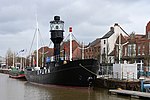Hull Trinity House

The Hull Trinity House, locally known as Trinity House, is a seafaring organisation consisting of a charity for seafarers, a school, and a guild of mariners. The guild originated as a religious guild providing support and almshouses for the needy, and established a school for mariners in 1787. By the 18th century it had responsibilities including management of the harbour at Hull, and buoys and pilotage in the Humber Estuary. After the loss of many of its responsibilities as a result of the Humber Conservancy Act of 1852, the guild continued its work as a charity, and the provision of education, which continues to the present day. The school, now known as Hull Trinity House Academy, is now a secondary boys' school. The charity, Hull Trinity House Charity, supports seafarers and their families; supported by property holdings, it operates rest homes, as well as Welton Waters Adventure Centre.
Excerpt from the Wikipedia article Hull Trinity House (License: CC BY-SA 3.0, Authors, Images).Hull Trinity House
Trinity House Lane, Hull Old Town
Geographical coordinates (GPS) Address Nearby Places Show on map
Geographical coordinates (GPS)
| Latitude | Longitude |
|---|---|
| N 53.74228 ° | E -0.3353 ° |
Address
Trinity House
Trinity House Lane 25
HU1 2EX Hull, Old Town
England, United Kingdom
Open on Google Maps










